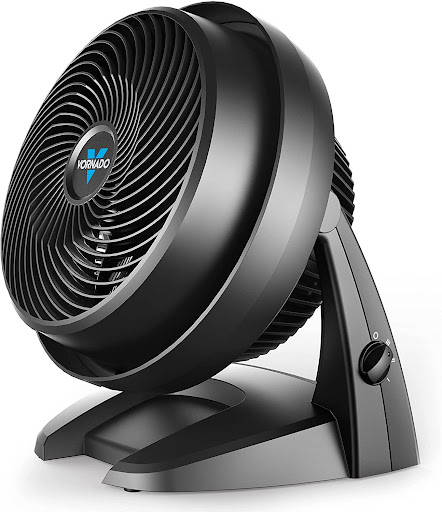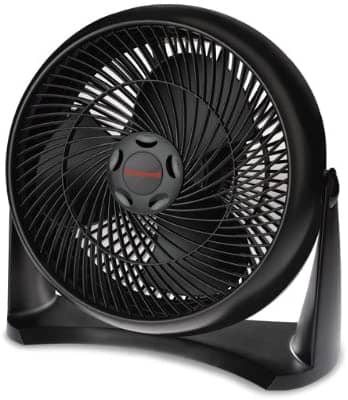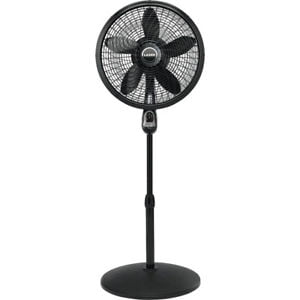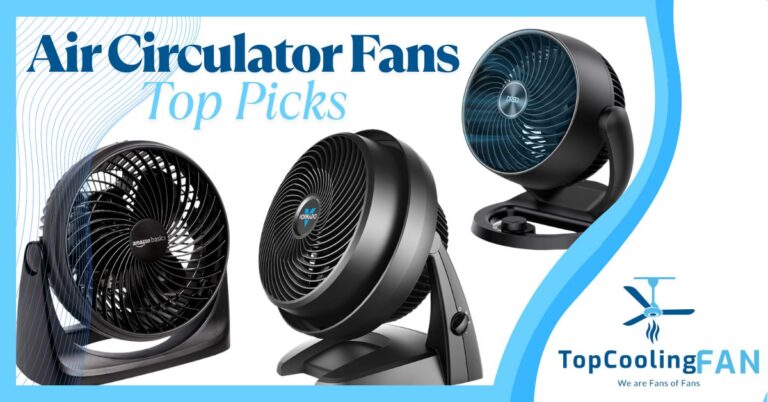Air Circulator vs Fan: The Ultimate Comparison
Understanding the differences between an air circulator and a traditional fan is crucial for making an informed decision about which product is better suited for personal needs.
An air circulator works to continuously move air around a room, keeping the temperature consistent throughout the space. This type of device is known to be highly effective in enhancing room comfort, not just by cooling but also by improving overall air circulation.

On the other hand, traditional fans focus on providing immediate relief in a fixed direction, offering a breezy escape from the heat. They tend to be pointed towards a particular area for direct cooling, and they work best in situations where a quick, concentrated blast of air is desired.
While they don’t promote the same level of air movement throughout a room as air circulators do, fans are often preferred for their simplicity and ease of use.
Each option has its unique benefits depending on the environment they are used in, energy efficiency, and the specific cooling or air circulation needs of the user. Whether choosing an air circulator for a more even distribution of air or opting for a traditional fan for spot cooling, awareness of these distinctions can guide consumers to the best choice for their comfort and lifestyle.
Understanding Air Circulators And Fans
Choosing between an air circulator and a traditional fan depends on one’s needs for air movement and cooling. Air circulators excel in keeping air in motion across a room, while traditional fans are better suited for direct, personal cooling.
Defining Air Circulators
An air circulator works on the principle of vortex action to move air throughout a room. Its design typically involves a combination of aerodynamic elements such as specialized blade design and powerful motors to create a steady and consistent airflow.
This airflow helps maintain an even room temperature by continuously circulating air. Unlike typical fans, air circulators do not just create a breeze in one direction; they optimize air circulation to balance room temperatures.
Defining Traditional Fans
Traditional fans, on the other hand, are generally designed for immediate cooling and are highly versatile. They come in various forms, including pedestal, table, and box fans, each with a fan blade design tailored to provide a wind-chill effect where the air is pushed directly onto the user or in a specific direction.
The design of traditional fans is simpler, focusing on providing relief from heat by blowing air over a person or area, rather than moving air throughout an entire space.
Key Differences

When deciding between an air circulator and a traditional fan, it’s important to consider their specific characteristics in terms of air flow patterns, cooling mechanisms, and overall design including form factor.
Air Flow Patterns
Air circulators are engineered to create a vortex action that keeps the air moving throughout the entire room, which promotes better air quality and even temperature distribution.
Traditional fans, however, generally produce a directed airflow and are optimized for a wind-chill effect in the immediate area they face. This is because they lack the advanced aerodynamic blades of air circulators like the Vornado, which are designed to move air more effectively.
Cooling Mechanism
The cooling effect of an air circulator is achieved by the constant motion of air that helps maintain a consistent temperature throughout the space.
In contrast, a fan provides cooling by blowing air directly on individuals, creating a breeze that helps evaporate perspiration and reduce body temperature. The method of oscillation is common in fans, aiding in distributing airflow across a wider area.
Design & Form Factor
In terms of design, air circulators frequently have a more modern aesthetic and incorporate features that allow for multidirectional airflow, including the ability to direct air vertically or at an angle.
They are often more compact in design, which can be beneficial for various room sizes and setups. Fans, including pedestal and table fans, have a traditional design, with larger blades that can take up more space and might not blend as seamlessly into a room’s decor.
Advantages of Air Circulators
Air circulators offer significant benefits when it comes to maintaining a comfortable climate within a room. They’re not just about moving air; they’re about enhancing the environment in which they’re used.
Efficient Air Circulation
Air circulators are designed to move air more effectively throughout a room, ensuring that there are no hot or cold spots. In the summer, they work to produce a cooling effect, while in the winter, they can be aimed to distribute warm air from heating devices, promoting an even room temperature.
Year-Round Usability
The versatility of air circulators extends to their ability to be used throughout the year. Whether it’s dispersing warm air during the winter or facilitating the flow of cool air in the summer, air circulators adapt to different climatic needs, enhancing their overall performance.
Energy Efficiency
One of the most appreciated benefits of air circulators is their ability to help lower energy bills due to their energy efficiency.
By optimizing the air flow, they make heating and cooling systems work more efficiently, which can reduce the need for high-power settings and, in turn, save energy.
Advantages of Traditional Fans

Traditional fans, encompassing a variety of styles like tower fans, box fans, and pedestal fans, offer specific benefits that cater to diverse needs and preferences. From providing a direct cooling effect to being cost-effective, these fans have remained popular choices for personal comfort.
Targeted Cooling
Traditional fans excel at delivering a direct cooling effect when positioned to face a specific area. This is especially true for oscillating fans which can pivot to circulate air within a room effectively.
Pedestal fans and tower fans can be adjusted to target the airflow at different heights, making them versatile for cooling different sections of a room.
Cost-Effectiveness
When it comes to cost, traditional fans are generally more affordable than air circulators.
From initial purchase to maintenance and energy consumption, box fans and ceiling fans, for example, offer a lower-cost solution for those seeking a cooler environment without a significant financial investment.
Variety of Options
The traditional fan category presents a wide variety of options to suit personal tastes and performance needs.
Ceiling fans add aesthetic value and can be a permanent fixture in a room, while box fans are known for their robust performance in a portable format.
Tower fans, with their sleek design, fit well in modern interiors and often include features like multiple speed settings and built-in timers.
Considerations for Home and Office Use

When choosing between an air circulator and a traditional fan, one must consider the room size and layout, desired noise levels, and air quality needs. These factors are vital for achieving the optimal balance between comfort and functionality in both homes and offices.
Room Size and Layout
The effectiveness of air movement devices largely depends on the room size and layout.
Air circulators are designed to keep air moving throughout the entire space, optimizing room temperature and preventing stale air. They are particularly effective in larger spaces due to their ability to circulate air over great distances.
Traditional fans, on the other hand, offer oscillation features and may be preferred when direct, concentrated airflow is desired in a specific area, such as a personal workspace.
Noise Levels
Noise levels are a crucial consideration, especially in office environments where excessive sound can be distracting.
Some people find a fan’s hum to be a form of white noise that can aid concentration, while for others, the quieter operation of an air circulator may enhance comfort.
It is important to look for a device that maintains a balance between efficient airflow and noise production to suit the intended environment.
Air Quality
Improving air quality is essential for maintaining a healthy and comfortable indoor environment.
Air circulators can facilitate better ventilation by continuously moving air, which can help to distribute fresh air more evenly and reduce the buildup of pollutants.
For both home and office settings, ensuring that the chosen device adequately supports the fresh air needs of the space is key for maximizing comfort and minimizing stale air challenges.
Additional Features & Innovations

The evolution of air circulation technology has led to an array of additional features and innovations. These advancements aim to enhance user convenience, efficiency, and overall user experience.
Smart Technology
Modern air circulators like the Vornado 660 AE are increasingly harnessing smart technology.
Manufacturers equip these devices with Wi-Fi connectivity and compatibility with voice assistants like Alexa.
This integration allows users to control their air circulators through voice commands or mobile applications, offering a seamless and convenient user experience.
Energy-Saving Motors
Energy efficiency is a significant focus in the design of contemporary fans and air circulators. Models such as the Vornado 630 and Vornado Silver Swan Alchemy often feature DC-powered motors. These motors are known for their lower power consumption. Not only do they consume less energy, but they also offer an extended warranty, ensuring long-term savings and reliability.
Ease of Cleaning & Maintenance
Ease of cleaning and maintenance remains a priority for both fans and air circulators. The design of the oscillating fan, for instance, typically allows for simple disassembly. This makes regular cleaning less of a chore. Manufacturers aim for user-friendly maintenance to ensure their devices, such as those equipped with removable grilles, are as maintenance-friendly as possible. This attention to design helps extend the life of the product and guarantees that it continues to operate at an optimal level of energy efficiency.
Evaluating Cost and Performance

When comparing air circulators and fans, it’s essential to consider the initial purchase cost, potential for long-term energy savings, and expected durability and warranty. These factors greatly influence overall value and performance.
Initial Purchase Cost
Air circulators typically have a higher initial purchase cost compared to traditional fans. For example, a Vornado fan, known for its efficient air circulation, may cost more upfront than standard fans. This difference in cost reflects the advanced technology and design that allows for better air movement throughout a room.
Long-Term Energy Savings
Air circulators are designed to reduce power consumption and lower energy bills over time. They work by continuously moving air, which helps maintain a consistent temperature, potentially easing the workload on heating and cooling systems. While the initial cost may be higher, the energy bills can reflect savings in the long run due to improved energy efficiency.
Durability and Warranty
When considering performance, durability is crucial. Air circulators are often built to be more durable, and many come with a five-year warranty. For example, Vornado fans boast a longevity that justifies their higher initial cost. The extended warranty period indicates the manufacturer’s confidence in the lifespan of their product, which is a vital consideration for consumers.
Final Thoughts on Air Circulator vs Fan

Choosing between an air circulator and a traditional fan often comes down to the specific needs in terms of comfort, efficiency, and air quality within a home.
Air circulators differentiate themselves through their ability to consistently move air throughout a room. This can lead to more uniform temperatures and can help in enhancing the overall cooling efficiency. They actively work to distribute cool air during summer. They can also help during colder months by evenly distributing warm air, preventing hot and cold spots.
On the other hand, fans are typically sought after for their direct cooling effect and versatility.
They provide immediate relief by offering a wind-chill effect when faced directly toward a person or area. Their affordability and a variety of available styles, from tabletop to box fans, make them a conventional choice for quick and targeted comfort.
- Air Circulators:
- Enhance room temperature uniformity
- Support air quality by continuously moving air
- Contribute to efficient energy use in tandem with other systems
- Fans:
- Offer immediate cooling with a wind-chill effect
- Affordability and versatility in models
- Provide targeted comfort rather than whole-room circulation
For those who prioritize a more holistic approach to climate control and efficiency, an air circulator may be the preferred choice. It maintains better air quality by keeping it moving, which can be particularly beneficial for those sensitive to stagnant air.
However, for individuals seeking straightforward, on-demand cooling without the need for wide-reaching air distribution, a traditional fan might be more up their alley.

